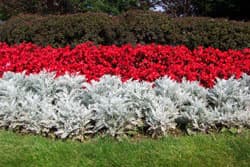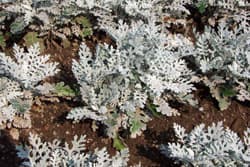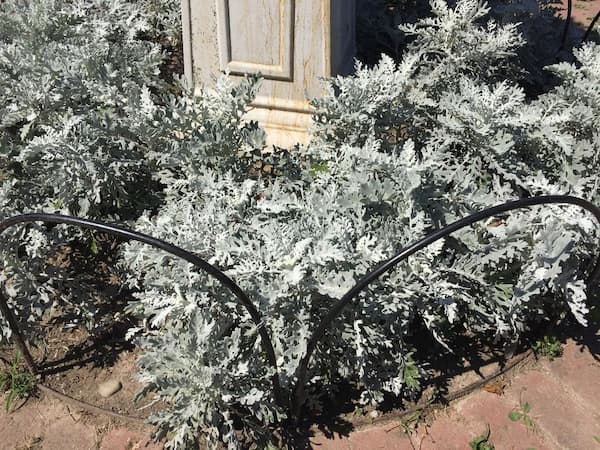How to Grow Dusty Miller Ornamental Plants

About Growing Dusty Miller Plants in your Yard
Dusty Miller plants are an easy-to-grow ornamental It makes an outstanding landscaping plant. This plant is grown for its silvery-gray, fern-like foliage. Dusty Miller makes terrific border and edging plants, offering a striking contrast to the colorful flowers and green colors of your lawn and garden. If you are growing Dusty Miller plants, you are doing so for the colorful foliage, and not for the flowers. If allowed, the plants will produce flowers. However, many gardeners pinch off the buds, as they are growing these plants strictly for the attractive foliage.
These plants look good in flowerpots on your patio or deck and in window boxes. Try mixing them with other flowering plants. Put a flowering plant in the middle of the flowerpot. The place Dusty Miller plants in an outer circle around it.
Dusty Miller Plant Specifications
Flower colors: Yellow.
Flowers Blooms: Summer.
Plant Height: Some varieties grow up to 3 feet.
Light Requirements: Full sunlight.
Ideal Soil pH: 5.5 – 6.0.
Hardiness Zone: 8 – 11.
Toxicity: Toxic to people and pets..
Deer Resistant? Yes.
Number of Species: 8
Native To: Mediterranean region.
Plant Type: Annuals and perennials.
Botanical Name: Jacobaea maritima
Other Names: Silver Dust
Are Dusty Miller Edible?
NO!!
Dusty Miller plants are toxic to humans and pets.
Medicinal Uses for Dusty Miller Plants
As previously mentioned, Dusty Miller is toxic to humans. Yet, despite this, there are some medicinal applications. We strongly recommend you know what you are doing, do your research, and speak with professionals before using Dusty Miller plants in home remedies.
Here are some of the potential medicinal applications:
- Use it for cataracts and other eye problems.
- Treat respiratory ailments.
- It is used for migraine headaches.
- Women have used it to bring on menstrual periods.
Light Requirements
Dusty Miller plants perform their best in full, bright sunlight. Give them 6 to 8 hours or more of full sun.
While the recommendation is full sun, the plants will grow with partial shade, as long as it is not too much. If the plants become leggy and their grey color appears somewhat faded, they are receiving too little sun.

Dusty Miller Plant Propagation
These plants are grown from seed. Sow Dusty Miller seeds early in the season, covering lightly with soil. Sow seeds outdoors two to three weeks before the last frost in your area. In southern areas of the country, they can be directly seeded into your garden in the fall, too.
Start plants indoors, six to eight weeks before the last frost in your area, will give an early start for these showy plants.
Final Plant Spacing: The final spacing for the plants is 10″-12″ apart. They will tolerate a little crowding.
Days to Germination: 10 – 15 days.

How to Grow Dusty Miller Ornamental Plants
These plants are very easy to grow. They prefer hot or warm climates. The plants grow best in full sun. However, they tolerate partial shade. Once established, they thrive for several years. Note: In colder areas of the country, they are grown as annuals.
The plants grow well in average soils. However, they perform their best in a rich, well-drained soil. Mix in plenty of compost before the first planting. Add organic mulch each season to replenish the soil.
The plants are somewhat drought-tolerant. Water them during dry periods, once or twice per week.
The plants are not big feeders. Add a general-purpose fertilizer once a month.
As previously stated, Dusty Miller plants do produce flowers. You can remove them if desired. Trim plants as needed, to maintain an attractive shape.
The plants will stay healthy and vibrant right up to the first frost in the Fall.
Pruning Dusty Miller Plants
You may find an occasional broken branch that should be removed for appearance. Otherwise, the plants will not need pruning.
Some people think the small yellow flower that blooms in the summer takes away from the appearance of the ornamental plant. If that’s you, remove the flower by sniping off the flower stem.
However, if you want to collect Dusty MiIler seeds, keep the flower on the plant until it dies off naturally and dries.
Insects and Plant Disease
Dusty Miller is resistant to most insects and plant diseases. Occasional aphid infestation can occur. At the first sign of aphids, treat the plans with neem oil.
If other insect or disease problems occur, treat early with organic or chemical insect repellents and fungicide.
Also see: Plant Problems – Identify the causes and find the cures.
Overwintering Dusty MIller Plants
These hardy perennials are easy to overwinter. After the first hard frost in the fall, the plant will die. Cut the plant back to near ground level.
Mulching for winter protection is not required.
Related Articles
People who read this article will also like:
How to grow Dusty Miller at Garden Hobbies
Please support our site. Shop for:
- rmmatthews100@hotmail.com
- 585-721-6528
- Rochester, NY
©1999-2024 GardenersNet.Com, All Rights Reserved

